Running an e-commerce business means juggling endless moving parts, all while trying to keep your books accurate. For most sellers, reconciling those figures in Xero or QuickBooks is the hardest part.
That’s where automation tools like A2X come in. Marketed as the gold standard for e-commerce accounting, A2X connects your sales channels (like Amazon or Shopify) to your accounting software, summarizing transactions so your books finally balance.
But while A2X has built a strong reputation for accuracy and reliability, many sellers discover that setup isn’t as simple as it sounds - especially if you’re managing multiple channels or handling VAT. That’s why an increasing number of UK and EU sellers are turning to Link My Books, a platform built to deliver the same automation with faster setup, built-in VAT logic, and one plan for all channels.
This guide breaks down what A2X actually does, where it shines, where it struggles, and how it compares to Link My Books so you can decide which tool fits your business best.
Key Takeaways from this Post
A2X automates payout reconciliation: It converts marketplace data from Amazon, Shopify, eBay, Etsy, and Walmart into clean summaries for Xero or QuickBooks.
Costs increase quickly for multi-channel sellers: A2X charges per marketplace, so adding extra sales channels often means paying for multiple subscriptions.
Link My Books simplifies automation for less: It includes all sales channels under one plan, automates VAT and OSS rules out of the box, and typically costs 30–40% less than A2X.







What Is A2X Accounting Software?
A2X is an accounting automation tool designed for e-commerce sellers using platforms like Amazon, Shopify, eBay, Etsy, and Walmart. It connects these marketplaces to accounting software such as Xero, QuickBooks Online, and NetSuite, automatically summarizing your sales, fees, refunds, and taxes into journal entries or invoices that match your bank deposits.
Instead of manually downloading reports, categorizing transactions, and adjusting VAT or sales tax, A2X does the heavy lifting by reconciling payouts automatically. This means fewer spreadsheet errors, faster month-end close, and a more accurate picture of your profitability.
A2X is particularly popular among accountants and larger online retailers because of its accuracy and reliability at scale. However, for smaller or mid-sized sellers, its manual tax setup and per-channel pricing can make it more complex and expensive to maintain - especially when compared with tools like Link My Books, which offer similar automation with simpler setup and built-in VAT logic.
Overview of A2X and Link My Books for E-commerce Sellers
Both A2X and Link My Books were built to solve the same core problem: the endless manual work of reconciling e-commerce payouts with accounting software. Sellers often spend hours trying to make marketplace settlements match their bank deposits, only to end up with discrepancies caused by fees, refunds, or tax differences.
These two platforms automate that process by sitting between your sales channels and your accounting system. They pull in data from marketplaces like Amazon, Shopify, eBay, Etsy, Walmart, and TikTok Shop, then push summarized, categorized entries into Xero or QuickBooks Online that match your actual bank deposits to the cent.
Where they differ is in design philosophy:
In short, A2X prioritizes scale and precision, making it a fit for accountants and large enterprises, while Link My Books focuses on speed, simplicity, and compliance, designed for growing multi-channel sellers who want automation that “just works.”
A2X at a Glance
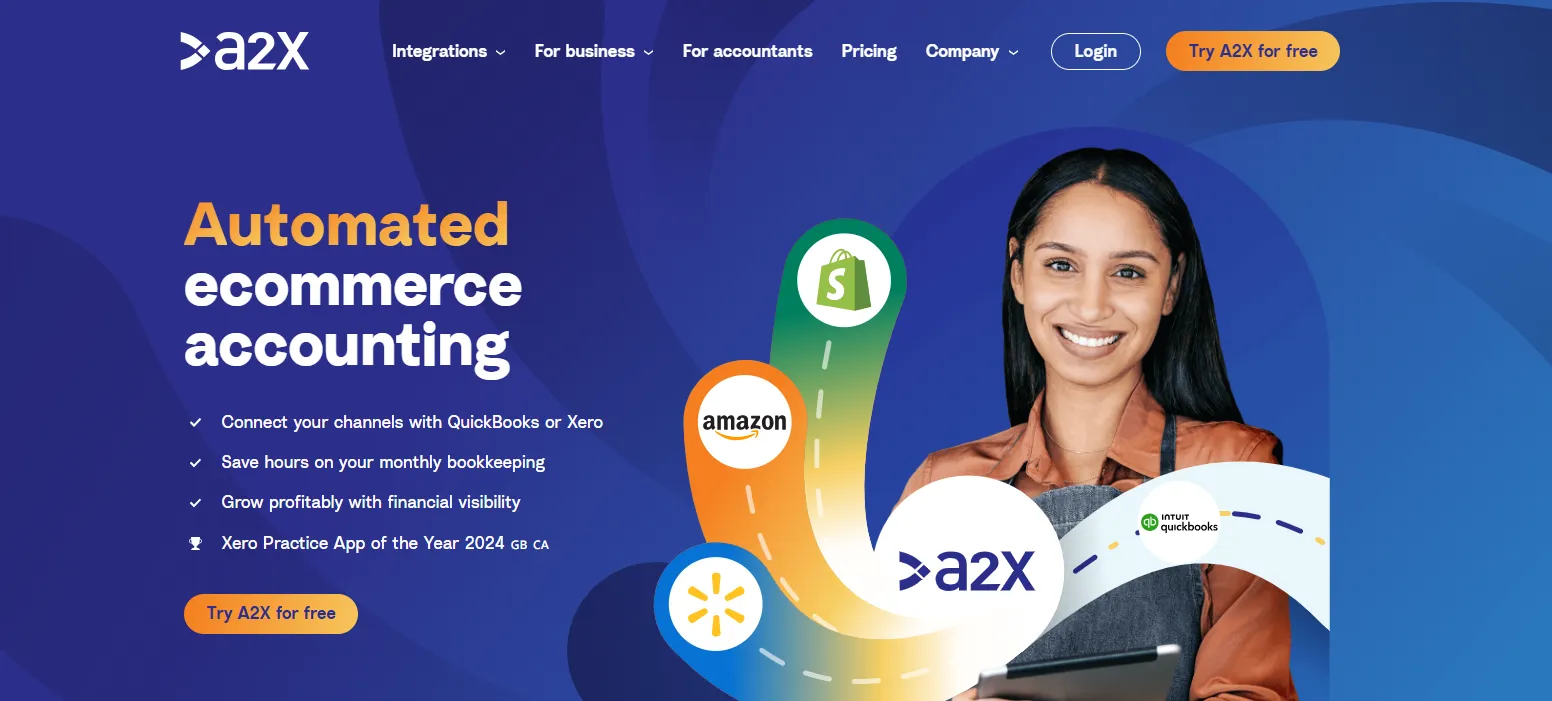
A2X is one of the most established accounting automation tools in e-commerce. Founded in New Zealand, it’s now used globally by sellers who need to reconcile high volumes of transactions across platforms like Amazon, Shopify, eBay, Etsy, Walmart, and BigCommerce.
At its core, A2X converts raw marketplace data into accurate, summarized entries for QuickBooks Online, Xero, or NetSuite. Each summary includes sales, fees, refunds, and taxes, aligning perfectly with the payout amounts shown in your bank feed — saving hours of manual work every month.
What A2X Does Well
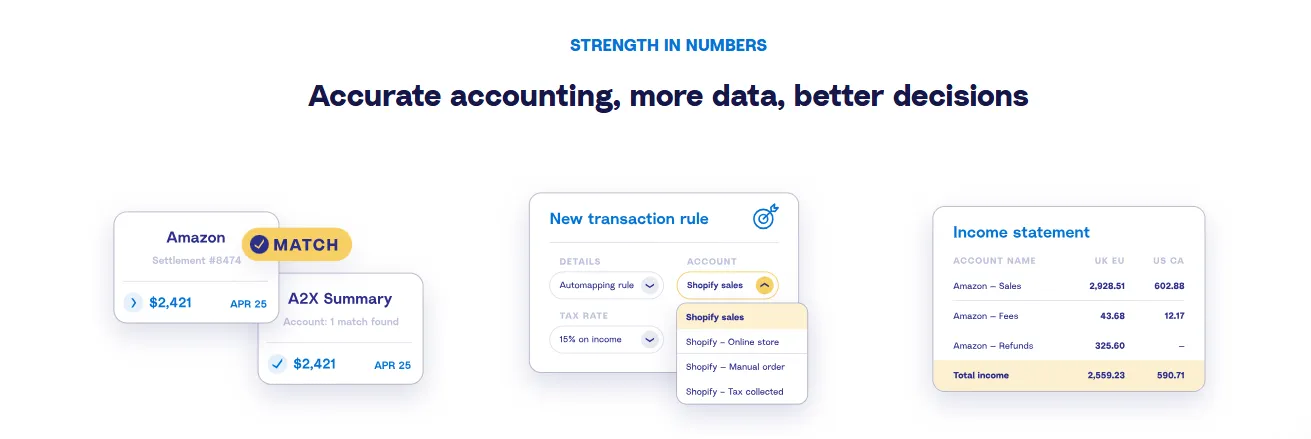
- Accurate reconciliation: Summarizes payouts to match your bank deposits automatically.
- Multi-platform support: Integrates with major marketplaces and multiple accounting systems, including NetSuite for enterprise users.
- COGS tracking: Allows sellers to upload SKU-level cost data or use Shopify “Cost Sync” to calculate Cost of Goods Sold and gross profit.
- Enterprise scalability: Handles large transaction volumes, multiple accounts, and cross-border sales efficiently.
- Reliable performance: Reviews frequently highlight stability and detailed reporting once setup is complete.
What Most E-Commerce Sellers Don’t Consider with A2X
- Manual tax mapping: VAT, OSS, and Marketplace Facilitator taxes aren’t automated. UK and EU sellers must map each code manually.
- Per-channel pricing: Each marketplace (e.g., Amazon, Shopify) requires its own plan or a costly multi-channel upgrade.
- Complex onboarding: Mapping transaction types and tax codes can take hours without accountant assistance.
- Limited analytics: Focuses strictly on reconciliation - no benchmarking or profitability insights.
A2X remains a powerful, accountant-approved tool for sellers that value accuracy and enterprise-grade reporting. But for smaller or VAT-registered sellers looking for faster setup and predictable costs, these same traits can feel like unnecessary complexity.
Link My Books at a Glance
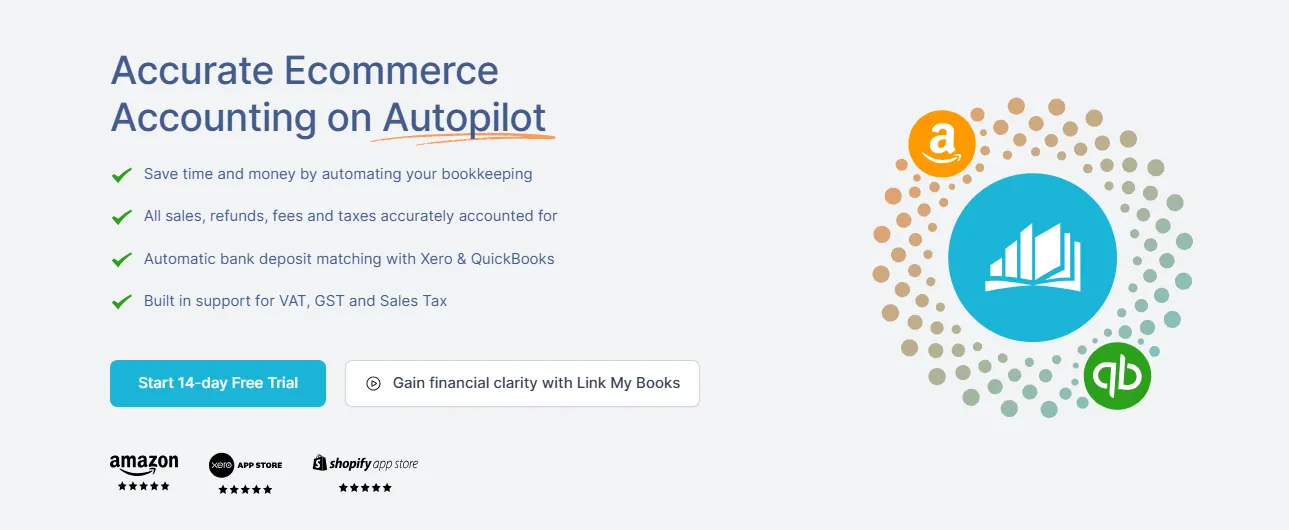
Link My Books was built to make e-commerce bookkeeping as simple and compliant as possible. Like A2X, it connects your sales channels directly to Xero or QuickBooks Online, but it goes further by automatically applying correct VAT, OSS, GST, or sales tax treatments - a major advantage for UK and EU sellers.
Instead of charging per marketplace, Link My Books uses a single subscription that scales only by order volume, meaning you can connect multiple channels (Amazon, eBay, Shopify, Etsy, TikTok Shop, Walmart, Square, and WooCommerce) under one plan.
Its setup process is designed for speed: a guided onboarding wizard walks users through mapping accounts, taxes, and categories in minutes. From there, each payout is summarized automatically to match your bank feed, creating clean, audit-ready records every time.
Key Features
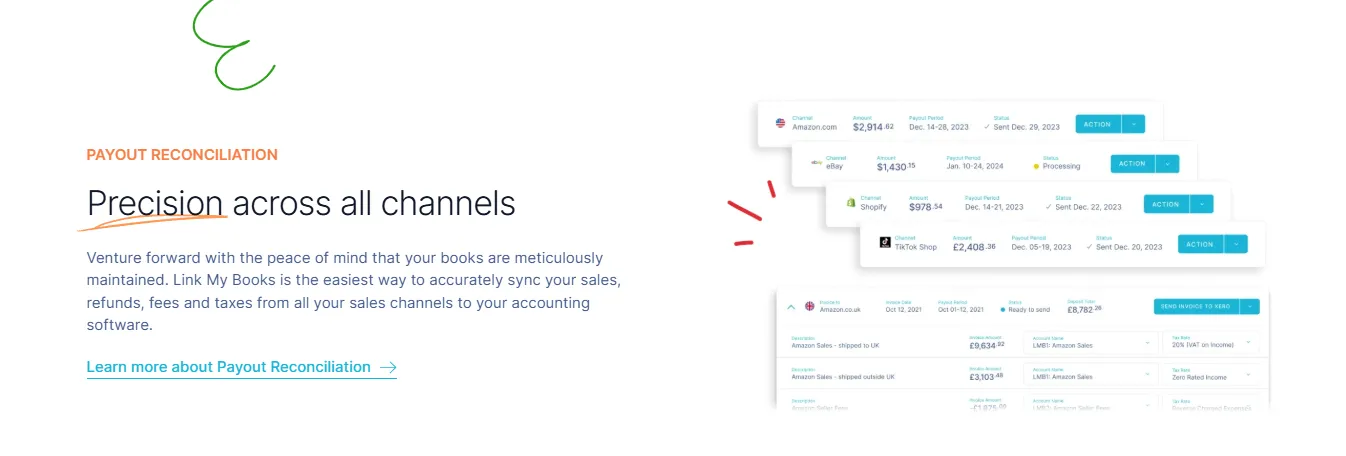
- Automated reconciliation: Sales, fees, refunds, and taxes are imported and summarized automatically.
- Built-in VAT and OSS compliance: Correct rates are applied per region without manual mapping.
- Multi-channel under one plan: No per-channel pricing - ideal for growing sellers.
- Guided setup wizard: Get up and running in under 15 minutes.
- Accountant-backed support: All support is handled by qualified accountants, not general tech staff.
- Analytics and benchmarking: View cross-channel profitability and compare performance to industry averages.
Why Sellers Choose Link My Books
- Saves hours of bookkeeping every month with clean, reconciled payouts.
- Prevents VAT overpayments and errors with automated tax mapping.
- Simplifies multi-channel accounting with one affordable, scalable plan.
- Provides fast, knowledgeable support from UK-based accounting experts.
For e-commerce sellers who want automation without enterprise complexity, Link My Books delivers the same reconciliation accuracy as A2X - but with faster setup, better tax compliance, and a pricing model designed for real-world sellers.

Want to see what Link My Books can do for you? 👉You can try it out for 14 days, free of charge!
A2X vs Link My Books: A Detailed Comparison
A2X vs Link My Books: Feature Highlights
Both A2X and Link My Books automate e-commerce accounting by turning complex sales data into reconciled journal entries in Xero or QuickBooks. But once you look under the hood, at how each handles VAT, multi-channel scaling, and pricing, the differences become significant.
Setup and Onboarding Workflow
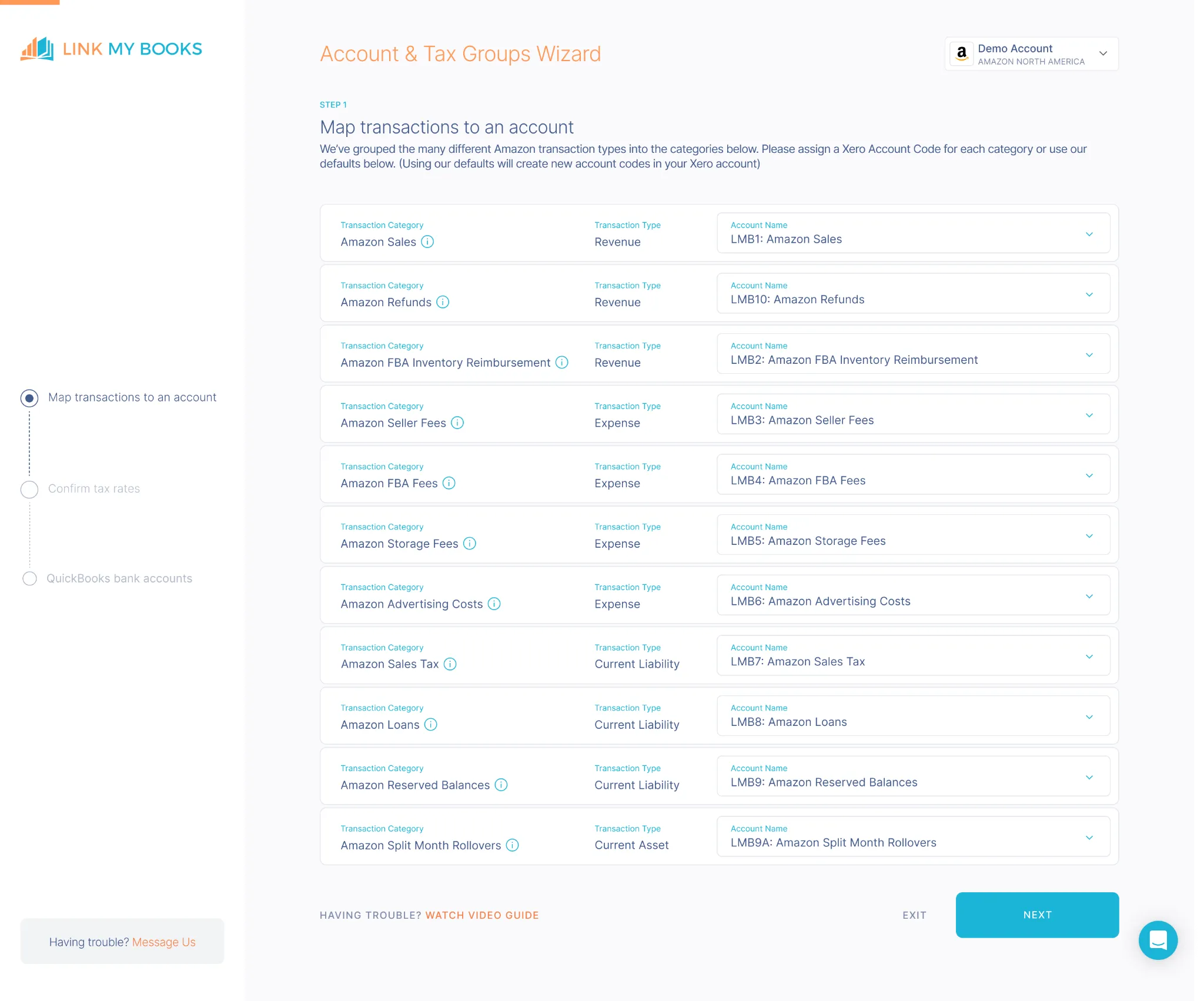
A2X: Setup involves connecting marketplaces, mapping accounts manually, and defining tax codes. Most users require help from an accountant or A2X’s onboarding team. Reviews on G2 and SoftwareAdvice describe the process as “accurate but time-consuming,” particularly when mapping dozens of Amazon transaction types. Higher-tier plans include 1:1 onboarding support, but for smaller users, setup can take several sessions to complete.
Link My Books: The guided Setup Wizard simplifies everything - from connecting accounts to assigning chart of account mappings and confirming VAT rules. New users can complete setup in under 15 minutes, even with multiple sales channels. Once configured, the platform automatically remembers your preferences for future payouts.
Verdict: A2X setup is accountant-grade; Link My Books setup is business-owner-friendly. For sellers new to automation, LMB’s workflow is objectively faster and easier.
VAT, OSS, and Tax Automation
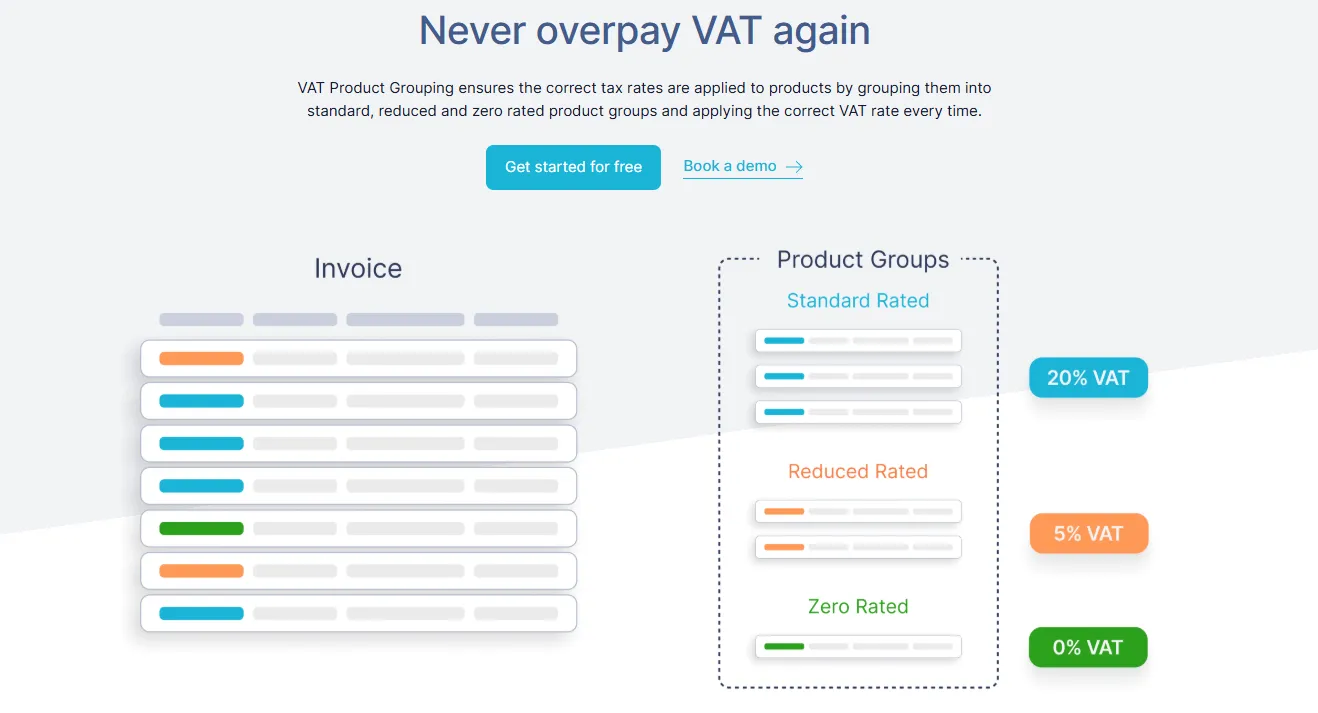
A2X: A2X is designed primarily for accuracy and scalability, but does not automate VAT or OSS logic. Users must manually configure tax codes for each account and transaction type within Xero or QuickBooks. The platform’s help documentation clarifies that it “does not calculate tax” - instead, it posts summarized sales data and relies on your accounting software’s settings to apply tax rates.
This flexibility can be beneficial for enterprise accountants who want total control, but it increases the chance of VAT duplication or omission. For example, UK and EU sellers must manually separate marketplace-collected VAT (e.g., Amazon or eBay MOSS) from seller-collected VAT to avoid overreporting. This process can take hours per marketplace and needs updating whenever marketplaces change VAT behavior.
Link My Books: VAT and OSS automation is built into the core logic. Link My Books automatically distinguishes between:
- Marketplace-collected tax (e.g., Amazon or Etsy VAT on behalf of sellers)
- Seller-collected tax (transactions where the seller remains liable)
- Cross-border transactions (applying zero-rated or OSS rates where relevant)
This built-in intelligence means you don’t have to touch tax mappings. Every transaction is automatically tagged with the right rate for HMRC or EU OSS compliance. For US sellers, Link My Books also separates Marketplace Facilitator sales tax, ensuring clean state-level reporting.
Verdict: A2X offers flexibility but demands accounting expertise; Link My Books handles compliance automatically. For UK/EU businesses, that’s the difference between hours of setup and instant compliance.
Cost of Goods Sold (COGS) and Profitability Tracking
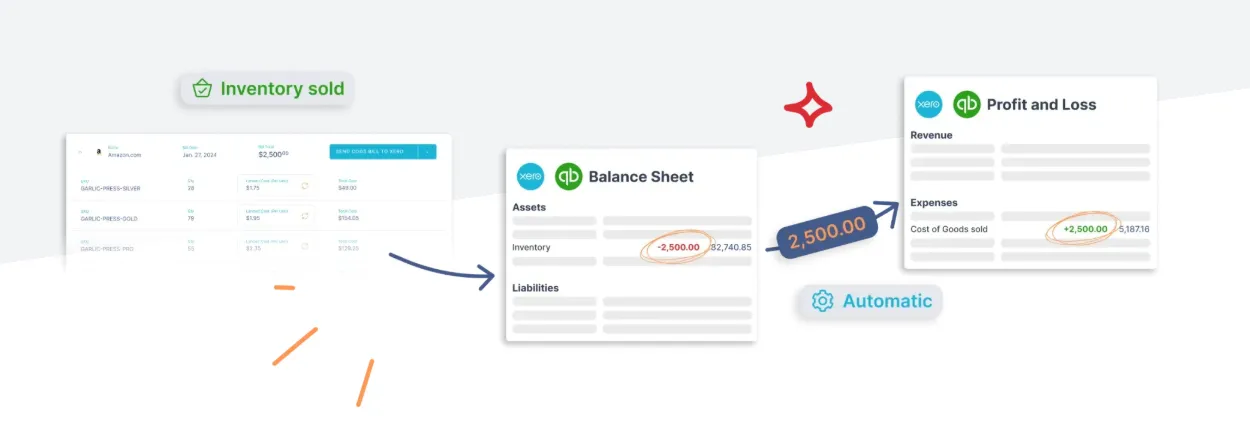
A2X: A2X provides advanced COGS functionality through integrations like Shopify Cost Sync and Settle for landed cost accounting. This allows enterprise users to track true profitability by factoring in freight, duties, and tariffs at SKU-level granularity. However, this setup can be complex - users need to import cost data manually or rely on inventory management software integration.
Link My Books: COGS tracking is integrated natively. Sellers can assign cost prices per SKU and have Link My Books automatically calculate COGS with each settlement. The system focuses on producing reconciled gross profit reports rather than deep landed cost accounting. It also includes industry benchmarking analytics, helping users compare margins against market averages.
Verdict: A2X wins on depth (landed cost integration); Link My Books wins on practicality and insights. For most SMBs, LMB’s COGS workflow provides 95% of the value with 10% of the complexity.
Historical Data
A2X: A2X allows importing up to 24 months of historical data, depending on the plan. This is useful for accountants performing catch-up bookkeeping or reconstructing prior-year financials. Each historical settlement is summarized identically to new ones, maintaining consistency.
Link My Books: Similarly, Link My Books supports up to 24 months of historical imports, available as part of its Pro and higher-tier plans. Sellers can also purchase historical data bundles separately - ideal for accountants migrating clients mid-year.
Where LMB differs is in its real-time analytics dashboard, which overlays financial summaries across channels to show sales trends, fee ratios, and gross margins.
Verdict: Both offer strong historical import tools, but LMB adds performance analytics and benchmarking - something A2X doesn’t include.
Reporting Depth and Financial Visibility
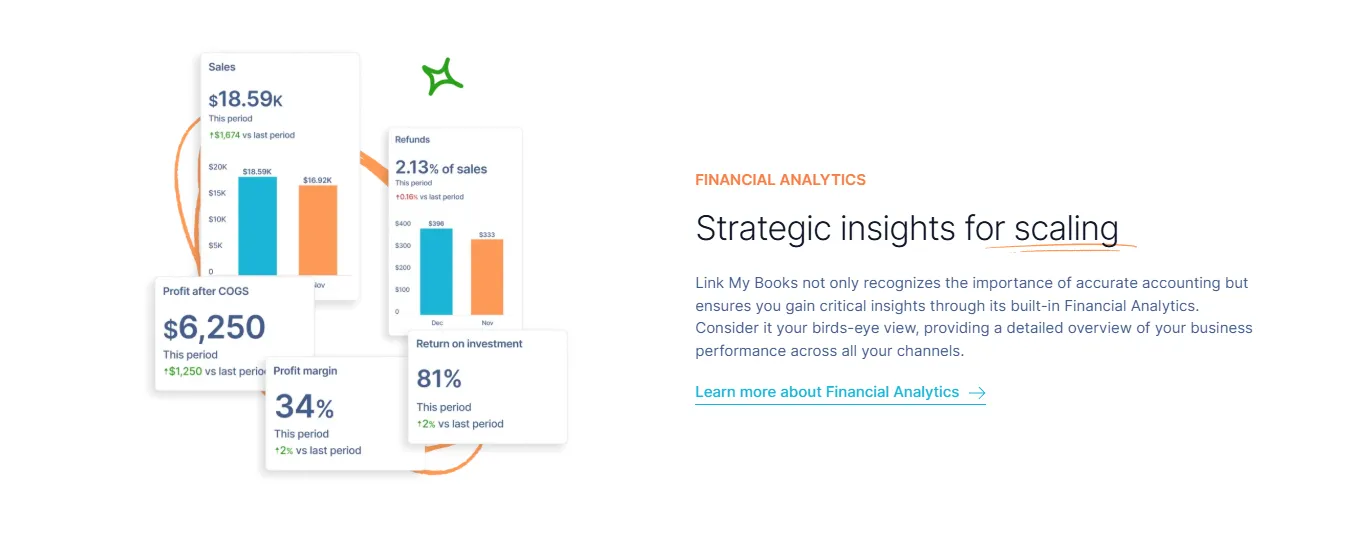
A2X: A2X’s reporting is designed for accuracy and auditability, not analysis. The system produces highly reliable journal summaries that reconcile perfectly with marketplace settlements, but the data stops there - it doesn’t include performance metrics or insights.
Accountants can export summarized entries and cross-check P&L impact, but A2X offers no dashboard for KPIs, profitability ratios, or tax exposure tracking. Reporting remains within your accounting software - meaning you must use Xero or QuickBooks reports to visualize margins, fees, or trends.
That makes A2X a backend engine: powerful for reconciliation, limited for financial strategy.
Link My Books: Link My Books extends beyond reconciliation into financial intelligence. Its built-in analytics dashboard aggregates data across channels, displaying:
- Cross-channel profitability
- Fee percentage by platform
- VAT liability forecasts and OSS thresholds
- Month-on-month sales growth and refund rates
- Benchmarked performance vs. industry peers
These insights help sellers and accountants spot inefficiencies and tax exposure proactively. Accountants managing multiple clients can view aggregated profitability by client, making advisory work faster and more data-driven.
Verdict: A2X = pure accuracy/Link My Books = accuracy + insight.
For accountants or sellers seeking real-time profitability tracking, LMB provides the visibility A2X intentionally omits.
Integration Ecosystem
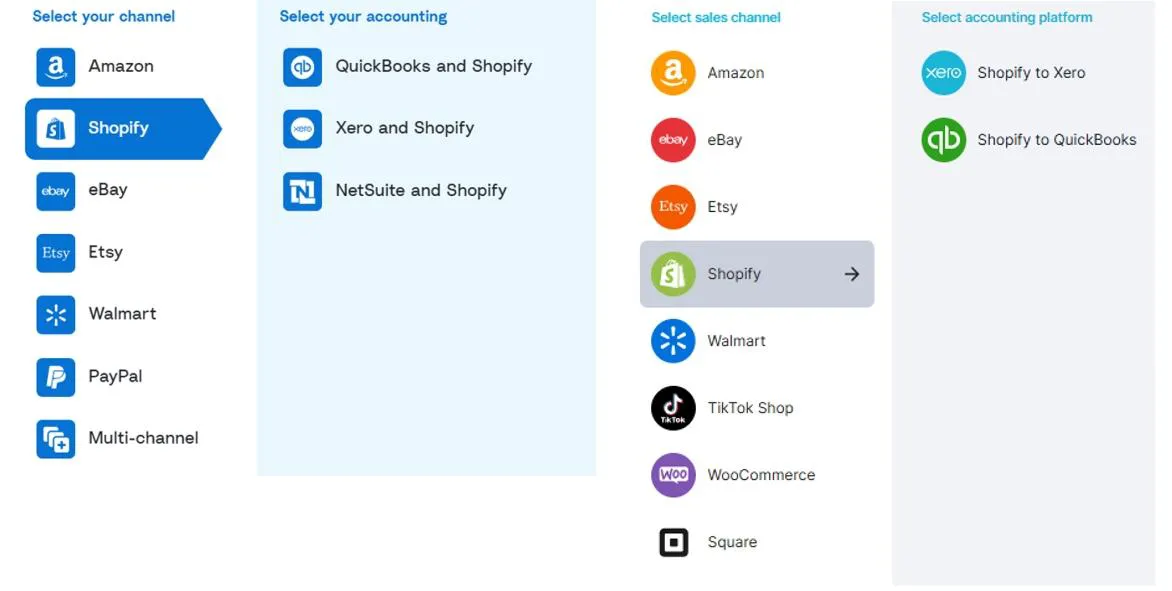
A2X: Integrates with Xero, QuickBooks Online, and NetSuite - a rare feature among e-commerce accounting tools. The NetSuite integration gives it an edge for enterprise-level operations. It also supports connectors for Shopify, Amazon, eBay, Etsy, Walmart, and BigCommerce.
Link My Books: Integrates with Xero and QuickBooks Online and connects to all major marketplaces - including TikTok Shop and Square, which A2X currently does not support.
Verdict: A2X’s NetSuite compatibility positions it for enterprise clients; Link My Books covers broader, modern retail ecosystems with SMB-relevant platforms like TikTok Shop and Square.
Multi-Channel and Scalability

A2X: A2X charges per marketplace. Sellers must subscribe separately for Amazon, Shopify, or eBay accounts, or purchase a “Multi-Channel” bundle. While this structure suits enterprise users who manage dedicated reporting per channel, it quickly becomes costly and complex for small to mid-sized sellers running multiple stores.
Each integration runs independently, requiring configuration and mapping within its own workspace - useful for accountants with separate client accounts but less efficient for multi-channel brands seeking unified reporting.
Link My Books: All channels (Amazon, eBay, Shopify, Etsy, TikTok Shop, Square, Walmart, WooCommerce) connect under one subscription. The pricing scales only by order volume, not by the number of channels. That means a single account can handle every marketplace, perfect for multi-channel growth.
In addition, Link My Books automatically consolidates reports from all platforms into unified dashboards for performance tracking. For accountants, this means managing dozens of client connections within one workspace rather than juggling multiple paid logins.
Verdict: A2X’s structure benefits large firms with client segregation; Link My Books wins on simplicity, scalability, and cost efficiency for multi-channel sellers.
Customer Support and Expertise

A2X: A2X’s support is widely praised across Trustpilot, Shopify, and Xero app stores. However, its team primarily provides technical support. Accountant-level help (e.g., mapping advice or VAT configuration) often requires premium-tier onboarding or third-party assistance.
Link My Books: Every support agent at Link My Books is a qualified accountant or bookkeeper. Support includes personalized guidance, walkthrough videos, and tax mapping explanations specific to UK, EU, and AU regulations. Response times average under one hour, and users can invite their accountants to collaborate directly in the app.
Verdict: A2X offers broad but general support; LMB provides specialized, accountant-grade help. This makes LMB particularly attractive for UK-based accountants managing VAT compliance.
Pricing Model and Value
Pricing is one of the biggest factors when choosing between A2X and Link My Books, especially for sellers operating across multiple marketplaces. Both tools use subscription tiers, but their pricing structures work very differently.
A2X Pricing
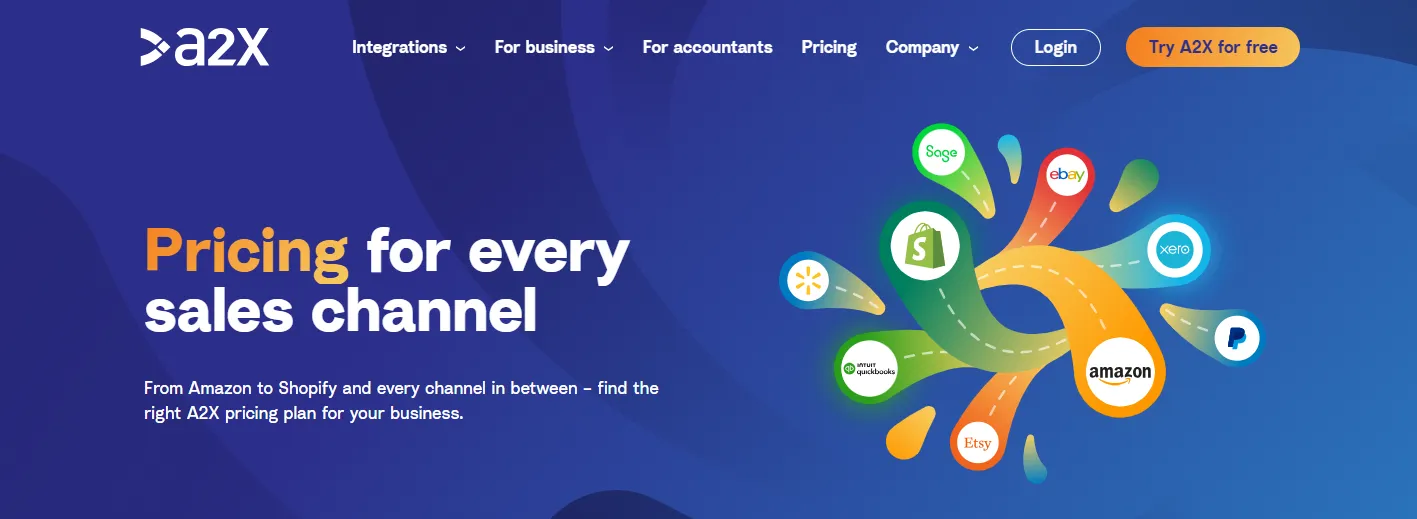
Per-channel pricing. One plan per marketplace. Multi-channel bundles exist, but cost scales rapidly with channels and order volumes.
- Amazon integration starts at $29/month for low-volume users (Mini tier).
- Higher tiers cover more orders: e.g. Standard ($79 for up to 5,000 orders), Standard 10K ( $159 ), Premium 15k, etc.
- Multi-channel plans allow combining multiple marketplaces under one umbrella plan. E.g. Multi 1K costs $89/month (for up to 1,000 orders across two channels).
- As order volume increases, so does the cost dramatically. They clearly highlight how moving from 5,000 to 10,000 orders can more than double pricing.
❗Every additional marketplace or rising order volume may require upgrading tiers or paying for a multi-channel package.
Link My Books Pricing

Order-based pricing. One plan covers all connected channels
- Link My Books emphasizes a scaling pricing model that charges based on your monthly cumulative order count across all channels, rather than per channel.
- Your order-volume tiers (200, 1k, 5k, 10k, etc.) are reference points - not separate channel plans.
- Entry pricing begins at $17/month (or equivalent), depending on volume.
- Unlimited marketplaces and seller accounts are supported under this dynamic model.
You can try out our interactive pricing tool and see where you land:
[cms-pricing-tool]
✅Sellers can add new sales channels without a discrete “channel fee” increase. Cost grows with volume only.
Side-by-side illustrative examples
Let’s compare real updated examples using the new data:
Verdict: A2X is best for single-channel, high-volume sellers or accountants billing clients separately; LMB offers transparent, scalable pricing for modern multi-channel commerce.
Suitability by Seller Type
What About A2X for Accountants and Bookkeepers?
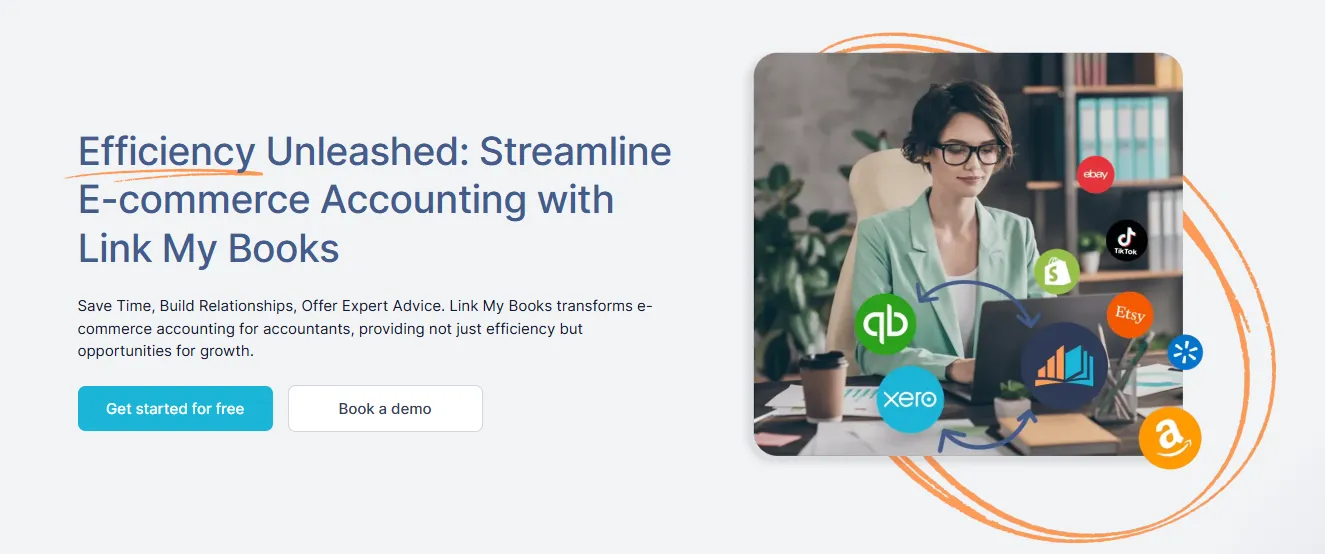
A2X has long been favored by accounting professionals who manage e-commerce clients, and for good reason. It was one of the first tools to translate marketplace data into clean accounting summaries for Xero, QuickBooks, and NetSuite. For firms handling large Amazon or Shopify portfolios, its reliability and consistency are undeniable.
However, as the e-commerce landscape has shifted - with sellers now operating across multiple platforms and tax jurisdictions - A2X’s strengths can also become limitations for accountants managing growing client bases.
Why Accountants Choose A2X
1. Accuracy and Audit Trail: A2X delivers precision-grade reconciliation. Each payout is translated into summarized journal entries or invoices that match bank deposits exactly, creating an auditable trail that accountants can trust. This level of transparency is particularly valuable for firms handling enterprise clients or those subject to frequent compliance reviews.
2. Client Segregation and Workspace Control: Each client in A2X has an independent workspace with its own channel connections, tax mappings, and chart of accounts. For practices managing multiple e-commerce businesses, this structure offers strong data isolation and customization, ensuring no overlap or confusion between clients.
3. Compatibility with NetSuite and Multi-Currency Accounting: Unlike most competitors, A2X integrates with NetSuite, making it a viable choice for firms serving enterprise clients using ERP systems. Its handling of multi-currency settlements also appeals to accountants managing cross-border sellers, particularly those transacting in USD, GBP, and EUR.
Where Accountants Struggle with A2X
1. Manual VAT Configuration for UK/EU Clients: For firms working with VAT-registered sellers, A2X requires each tax code to be configured manually in Xero or QuickBooks. This slows onboarding and increases the risk of clients misclassifying transactions.
Even small mapping errors - such as failing to separate Amazon-collected VAT from seller-collected VAT - can result in HMRC overpayments or inaccurate filings.
2. Per-Channel Pricing for Multi-Client Practices: Accountants managing multiple clients across several platforms face rising costs quickly. Since A2X’s pricing is per channel, firms must maintain multiple paid accounts - one for each marketplace per client. For practices serving dozens of clients, this can become prohibitively expensive compared to order-based models like Link My Books.
3. Limited Automation Beyond Reconciliation: A2X focuses entirely on reconciliation, not reporting or profitability. Accountants looking to deliver advisory insights (such as COGS analysis or cross-channel profit tracking) need to export data into spreadsheets or third-party BI tools. This adds extra steps that dilute the time savings A2X provides.
4. Slower Setup at Scale: While accurate, the mapping process for new clients can take several hours, especially when onboarding multiple marketplaces. Firms with junior staff or offshore bookkeepers often find the manual setup repetitive and error-prone, slowing overall client onboarding speed.
How Link My Books Compares for Accounting Firms

1. Built for Multi-Client Workflows: Link My Books was designed around accountants managing multiple clients. A single account can manage all clients’ integrations from one dashboard - no per-channel fees, no separate logins. This dramatically reduces administrative overhead for firms with high client volume.
2. Accountant-Grade Automation with VAT Intelligence: LMB automatically applies the correct VAT, OSS, GST, or sales tax rules for each client’s transactions, eliminating the need for manual setup. Accountants can rest assured that every payout is tax-compliant from day one, freeing them from routine error checking and year-end corrections.
3. Collaborative Access and Permissions: Each accountant can invite clients into their LMB workspace with read-only or full-access roles. This structure makes collaboration seamless - clients can monitor payouts and reports while accountants retain control of mappings and postings.
4. Value-Add Tools for Advisory Work: Link My Books includes profitability analytics and industry benchmarking, enabling accountants to deliver more than just bookkeeping. These insights help firms shift from data entry to strategic advisory services, increasing client retention and perceived value.
5. UK-Based Qualified Support Team: Every LMB support agent is a qualified accountant or bookkeeper, ensuring firms receive accurate, accounting-focused advice. Many accountants highlight this as the reason they migrated from A2X, as it saves hours of troubleshooting during client onboarding.
Verdict for Accounting Practices
FAQ: Everything You Need to Know About A2X
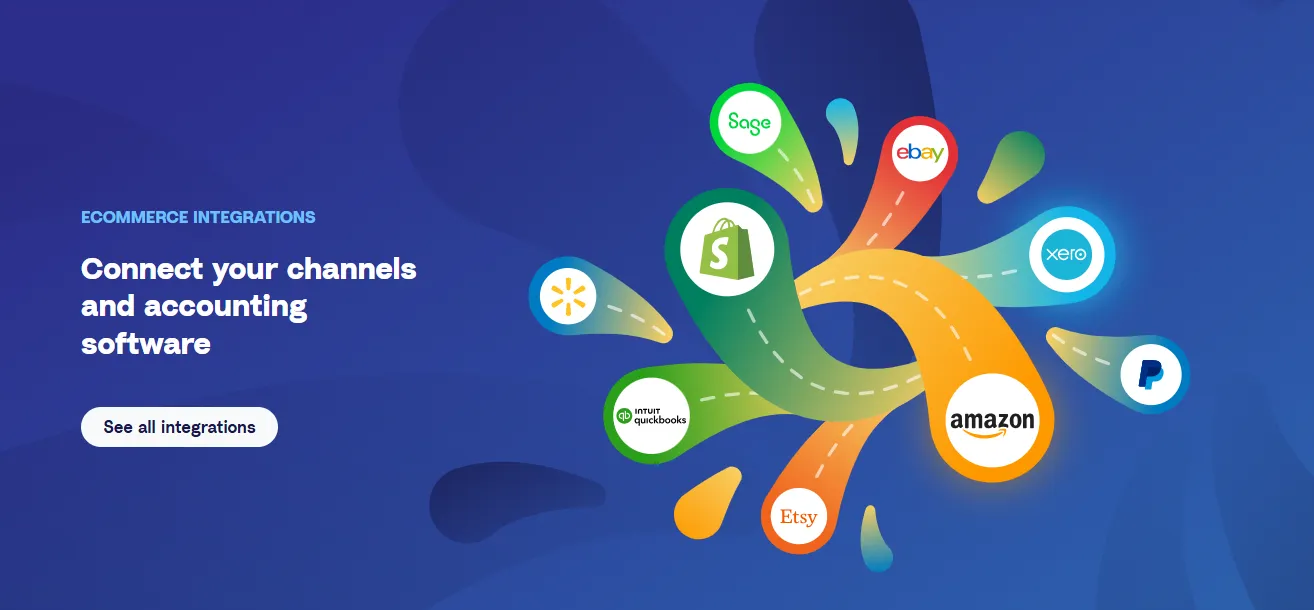
What does A2X do?
A2X automates the process of importing and summarizing payout data from e-commerce platforms such as Amazon, Shopify, eBay, Etsy, and Walmart into accounting software like Xero, QuickBooks Online, and NetSuite.
It converts complex transaction data – including sales, refunds, fees, and taxes – into journal entries that reconcile perfectly with your bank deposits. This eliminates the need for manual spreadsheets or guesswork when reconciling payouts.
For a detailed breakdown of how this process works with Amazon, see our guide A2x for Amazon accounting.
Who is A2X best for?
A2X is ideal for:
- Enterprise sellers operating at high transaction volumes
- Accountants managing large Amazon or Shopify clients
- Businesses using NetSuite or advanced ERP systems that require structured, auditable financial entries
However, smaller UK or EU sellers often find the manual VAT setup cumbersome. Those users typically prefer Link My Books, which automates VAT and OSS compliance out of the box.
How much does A2X cost?
A2X uses a per-channel pricing model, meaning each marketplace connection (e.g., Amazon, Shopify) requires its own subscription. Prices vary by order volume:
- Mini Plan: from $29/month (up to 200 orders)
- Standard Plan: $79/month (up to 5,000 orders)
- Multi-Channel Plans: start around $169/month for two channels
As sellers scale across multiple platforms, this structure can make A2X significantly more expensive than order-based tools like Link My Books.
See the latest breakdown in our full A2X pricing analysis.
Does A2X handle VAT or OSS automatically?
No. A2X does not automate VAT or OSS logic. It imports summarized sales data into your accounting software, but tax codes must be applied manually in Xero or QuickBooks.
For UK and EU sellers, this means mapping every tax type yourself or involving your accountant.
By contrast, Link My Books automatically applies correct VAT, OSS, or sales tax rates to each transaction, ensuring compliance without manual setup. Read more in A2X vs Link My Books.
Does A2X integrate with QuickBooks and Xero?
Yes. A2X connects directly to QuickBooks Online and Xero, posting summarized invoices or journals that match payout totals. It’s also one of the few e-commerce accounting tools compatible with NetSuite, making it a go-to for enterprise users with ERP systems.
Can A2X import historical data?
Yes. Depending on your plan, A2X allows you to import up to 24 months of historical settlements. This is useful for catch-up bookkeeping or migrating from manual reconciliation to automated posting.
Link My Books offers a similar feature, allowing accountants to bulk-import up to two years of historical payouts per channel and consolidate multiple platforms in a single dashboard.
Is A2X suitable for accountants and bookkeepers?
Yes, A2X is popular with accountants who value accuracy and detailed reconciliation. It provides a clean audit trail and supports multiple workspaces for client management.
However, accountants handling multiple VAT-registered clients often find Link My Books more efficient because it supports multi-client dashboards, automatic VAT mapping, and accountant-level permissions - all under one subscription.
Does A2X track profit or COGS automatically?
Partially. A2X offers COGS functionality that lets you upload SKU costs or connect Shopify’s “Cost Sync” for landed cost calculations. However, it doesn’t include profitability analytics or dashboards.
Link My Books, by contrast, tracks COGS automatically and displays cross-channel profit metrics and industry benchmarking, helping sellers understand their true margins in real time.
What are the main alternatives to A2X?
The most popular alternatives include:
- Link My Books – best for VAT-registered multi-channel sellers
- Synder – strong for US sellers needing real-time transaction syncs
- Taxomate – focuses on Amazon and QuickBooks users in the US
- Dext Commerce – preferred by accountants for bulk client management
See our full side-by-side comparison in A2X alternatives for pricing, features, and regional suitability.
Is A2X worth it in 2026?
If you’re an enterprise-level seller or an accountant managing large clients with NetSuite, A2X remains one of the most accurate tools for reconciliation.
But for SMBs, multi-channel sellers, and VAT-registered businesses, Link My Books provides a more complete and cost-effective solution - automating the parts of bookkeeping that A2X still requires you to do manually.
Check out A2X reviews to see what users say.
Streamline Your E-Commerce Accounting with Link My Books
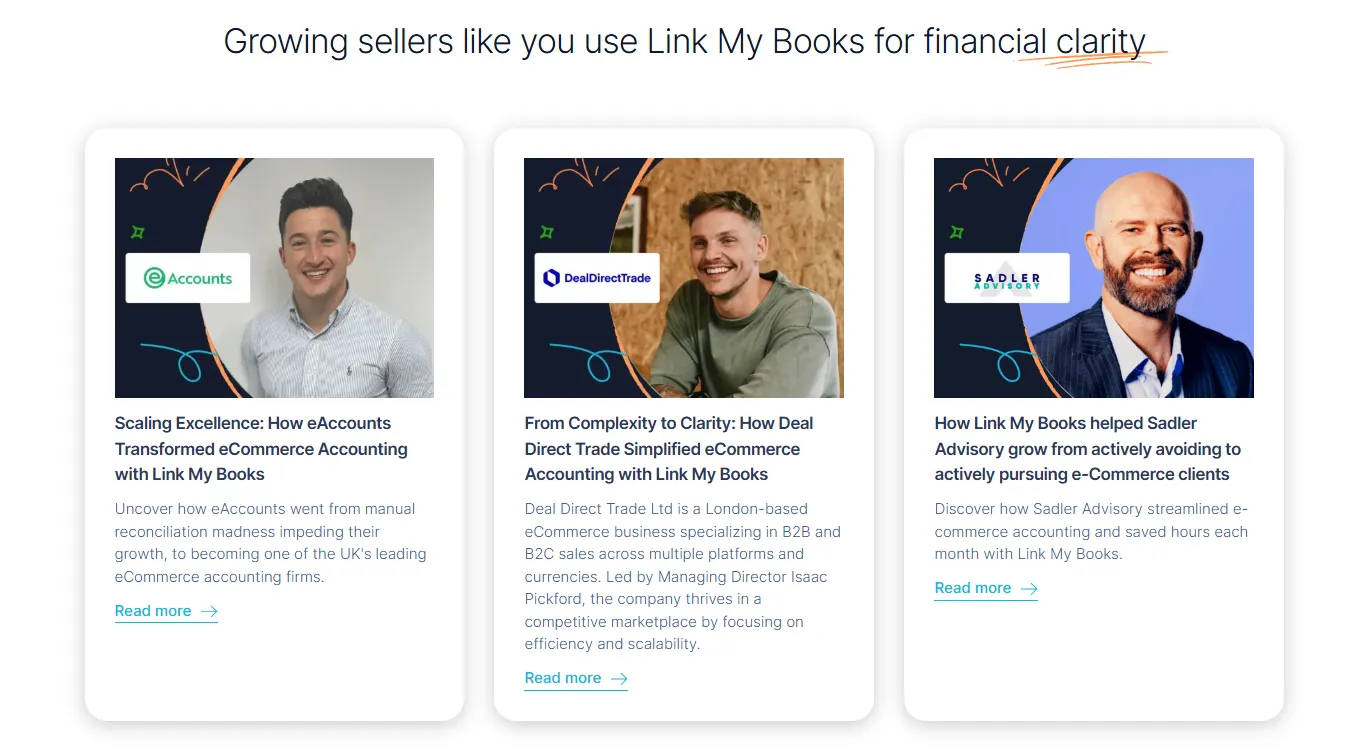
Most growing sellers today need something faster, smarter, and built around compliance from the start.
Link My Books delivers exactly that: automated reconciliation, built-in VAT and OSS logic, and transparent pricing that scales with your business, not your channel count. Whether you sell on Amazon, Shopify, eBay, Etsy, TikTok Shop, Walmart, Square, or WooCommerce, Link My Books syncs every payout directly into Xero or QuickBooks with complete accuracy.
Here’s what that means for you:
- No more manual tax mapping: VAT, OSS, and sales tax are applied automatically.
- No per-channel costs: One affordable plan covers all your sales platforms.
- Accountant-grade accuracy: Every entry matches your bank feed to the cent.
- Instant visibility: See your true profits, fees, and taxes in real time.
- Expert support: UK-based qualified accountants are always on hand to help.
For e-commerce sellers and accountants alike, this means one thing - peace of mind. Your books stay accurate, compliant, and up to date automatically, leaving you free to focus on growth.

👉 Start your free 14-day trial of Link My Books, or book a personalised demo, and discover how effortless automated bookkeeping can be.


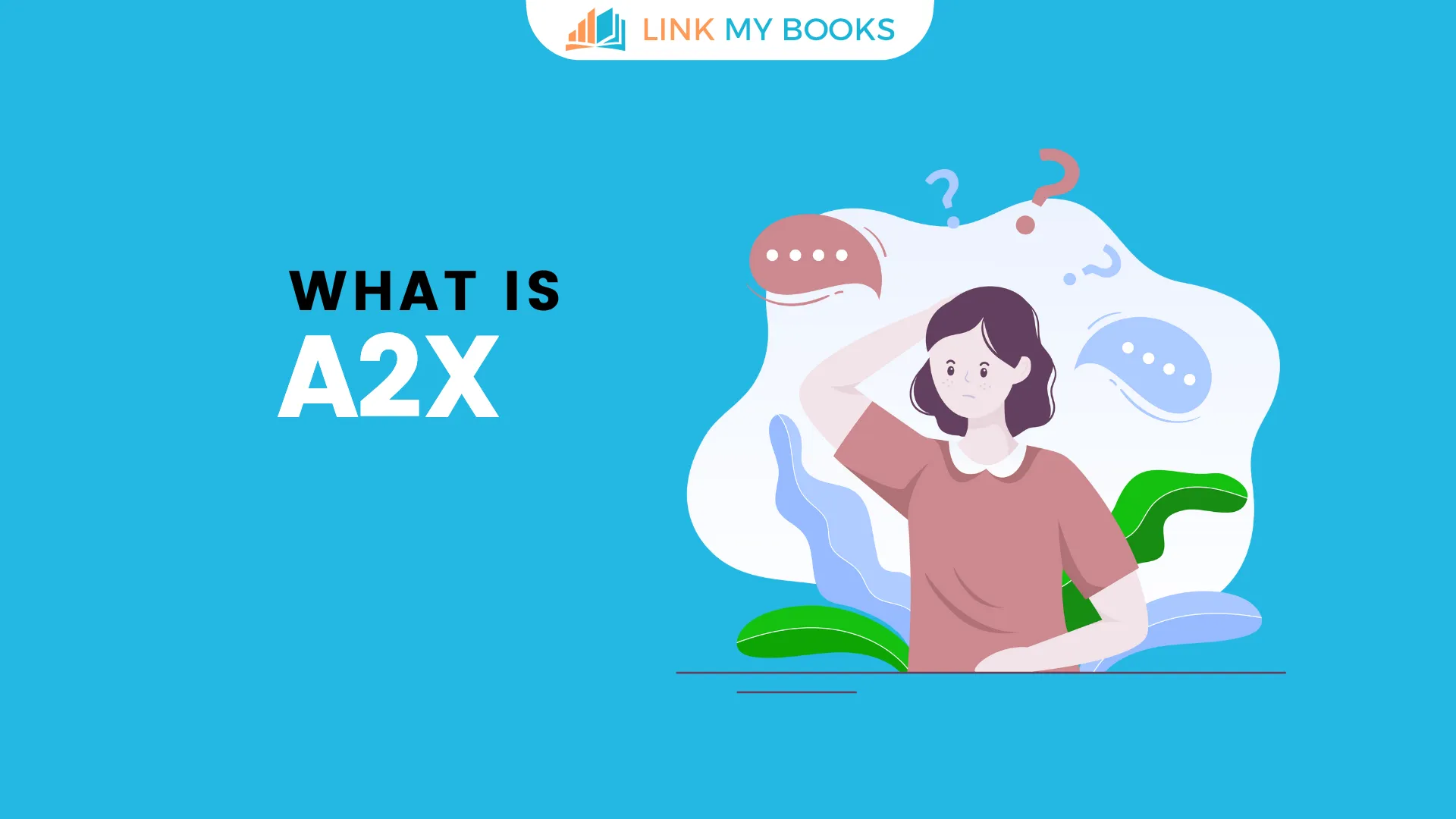







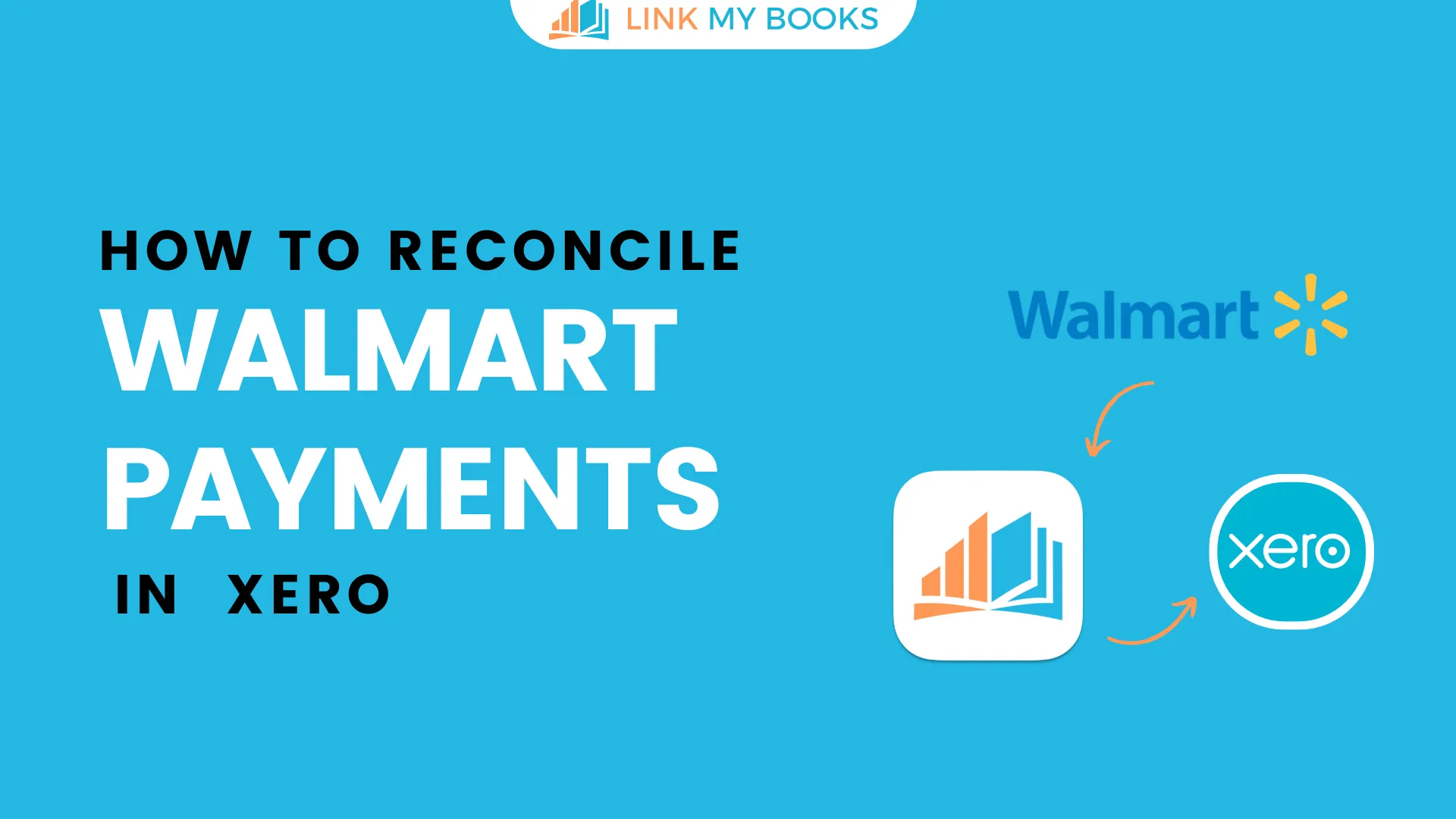
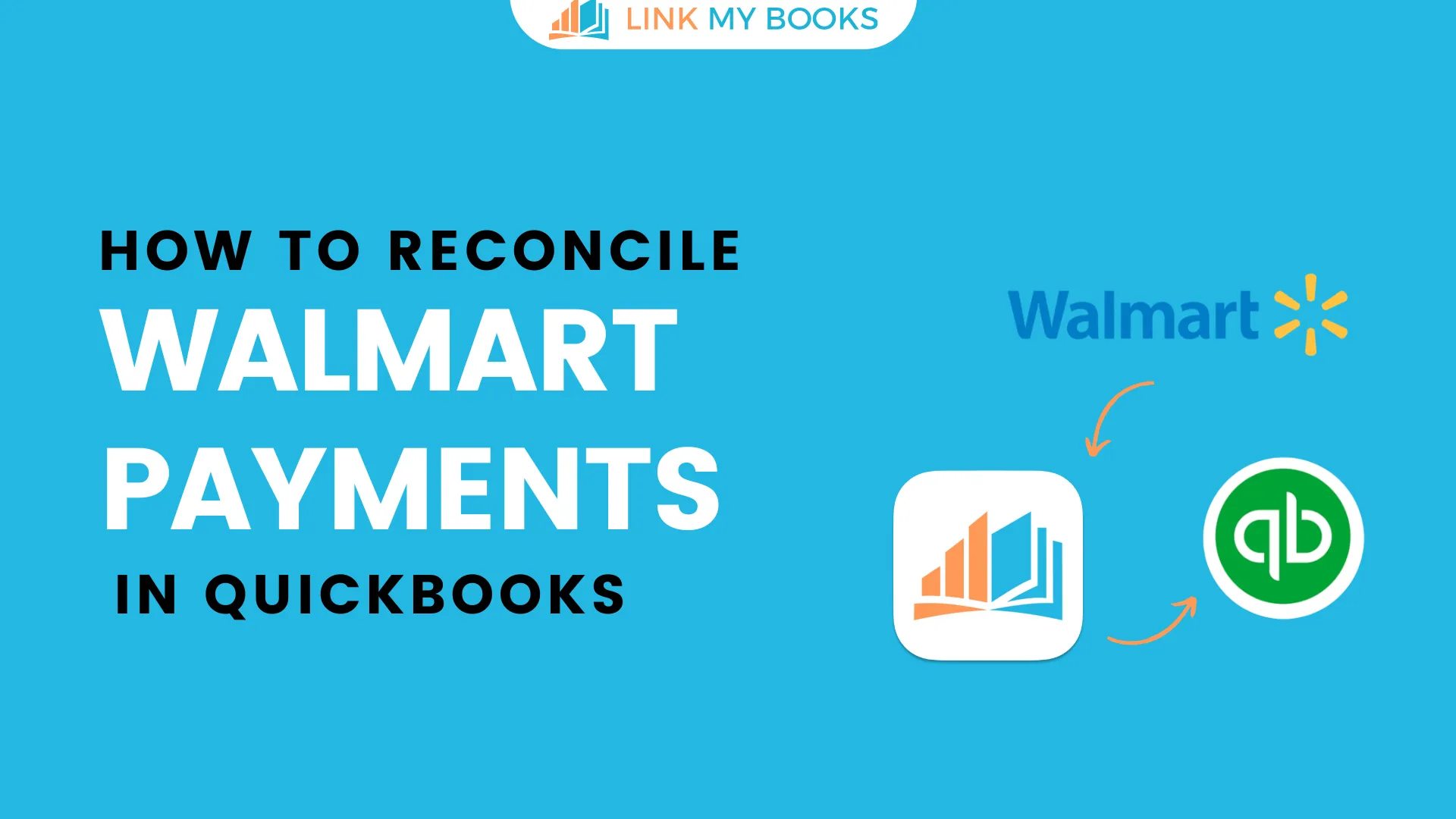
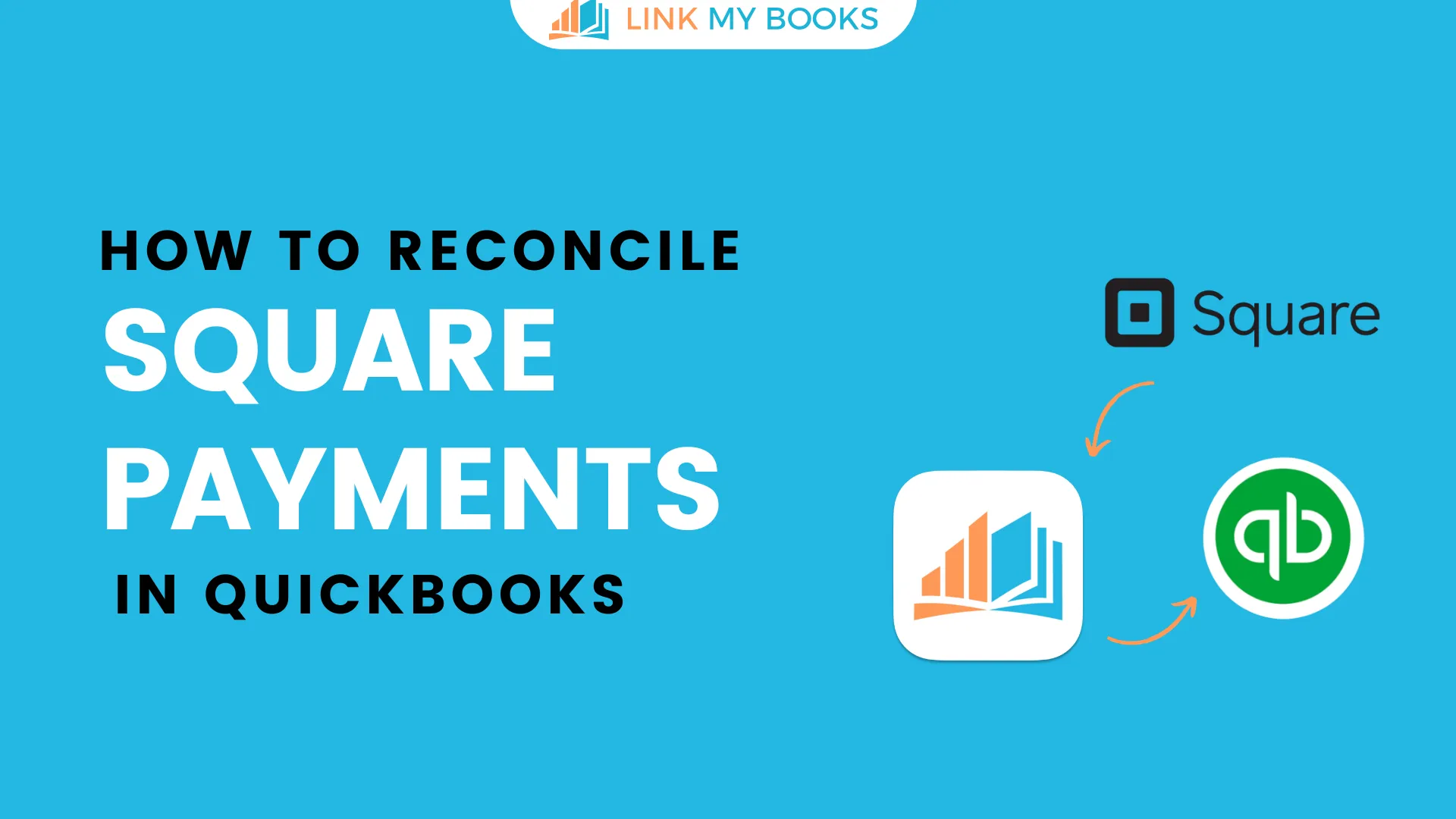
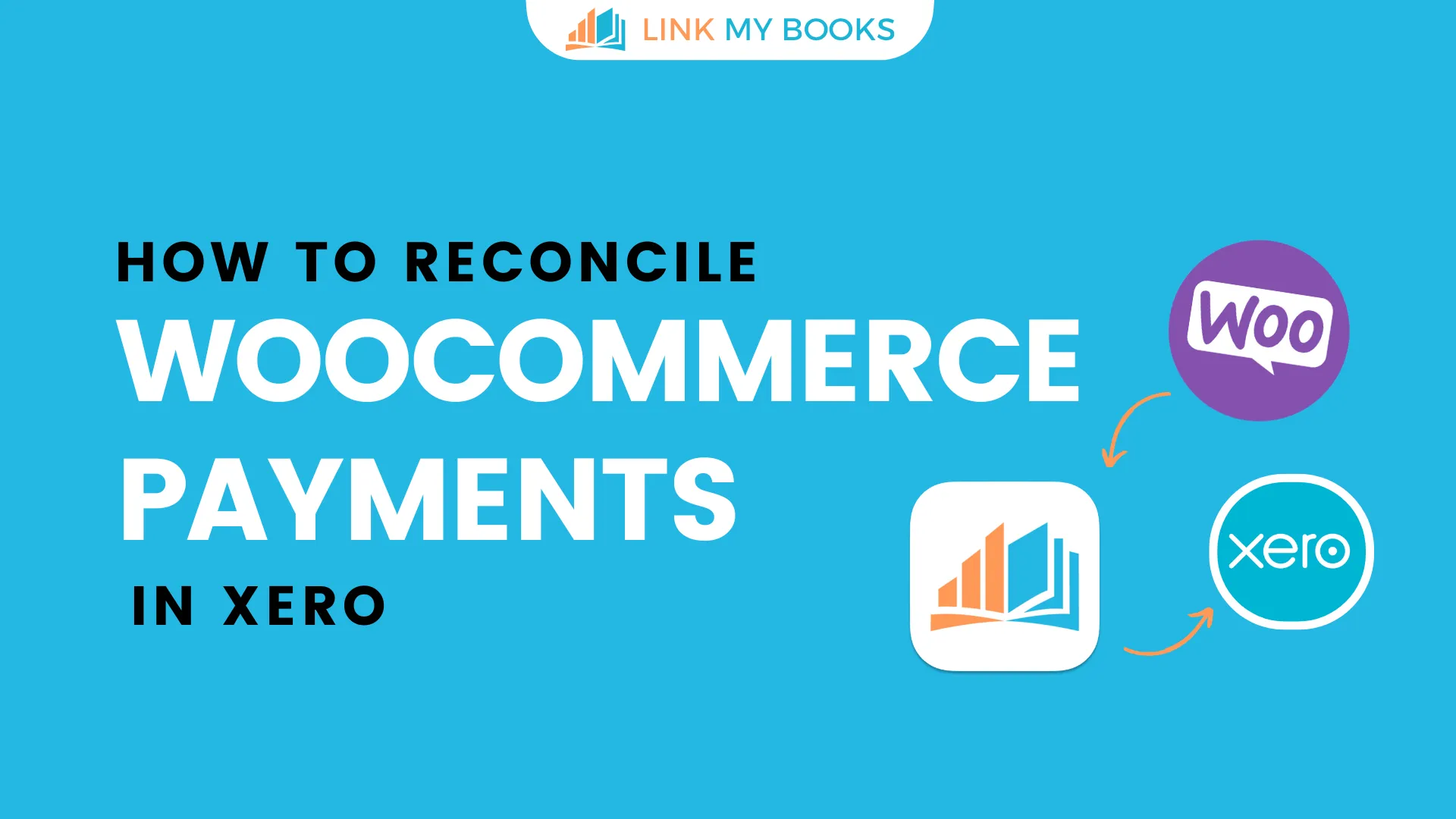
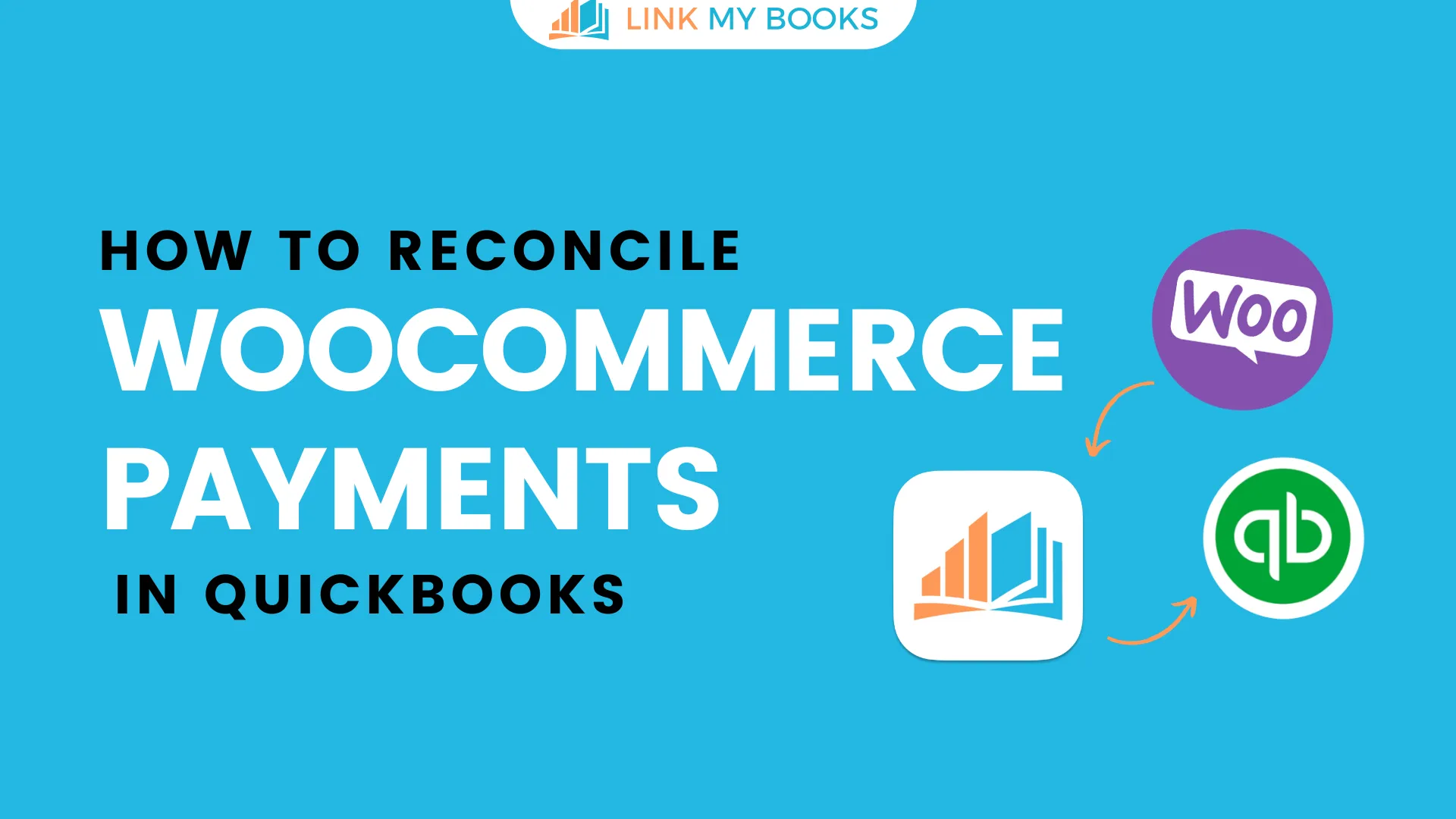
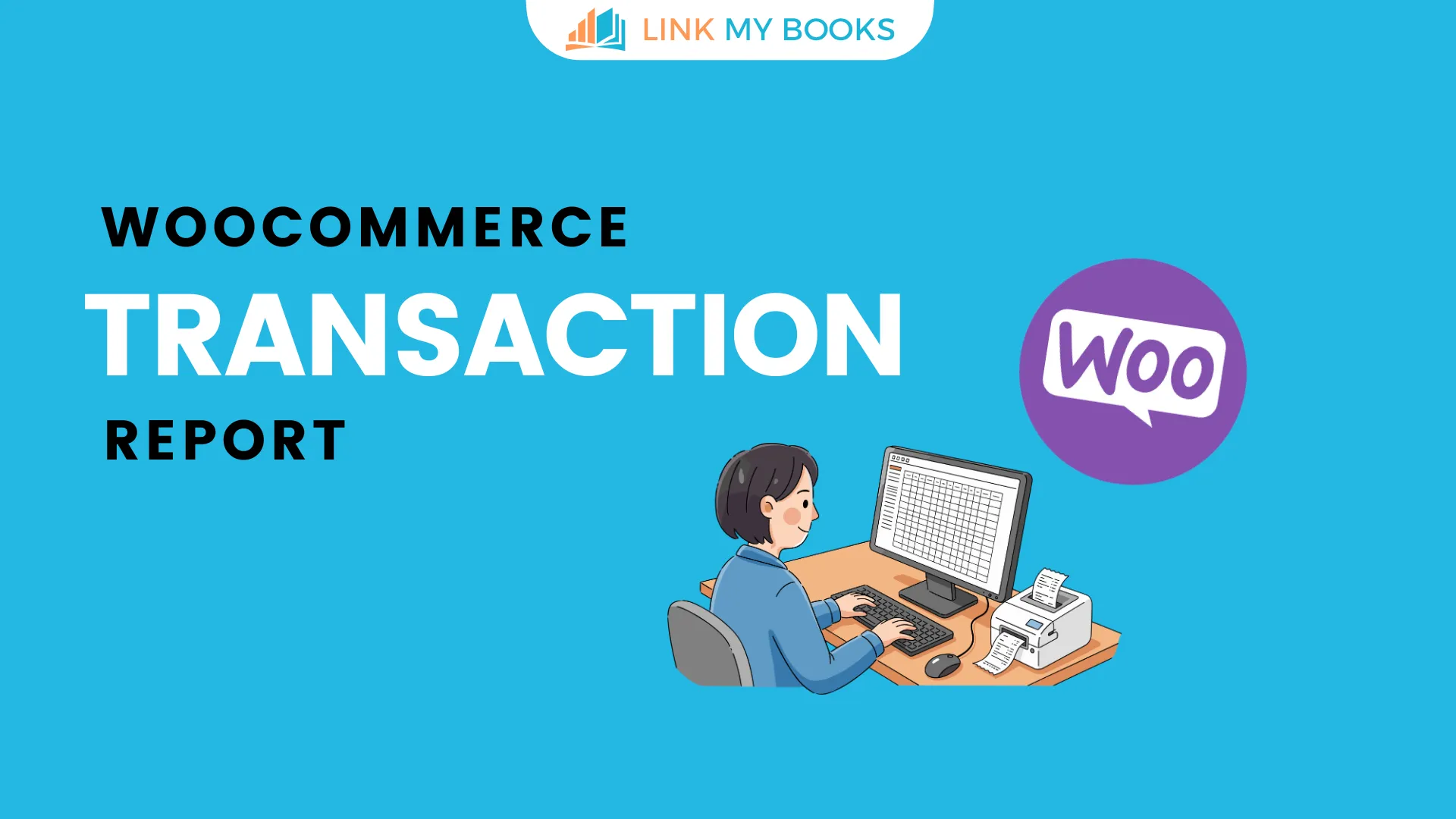


.png)